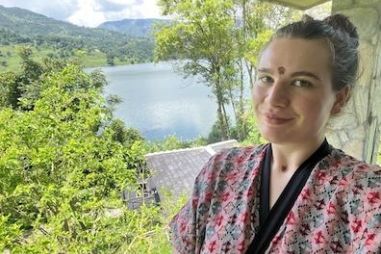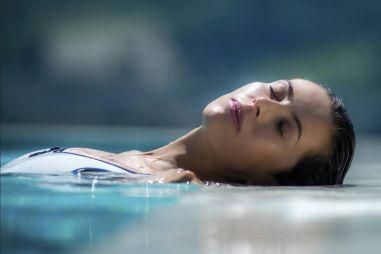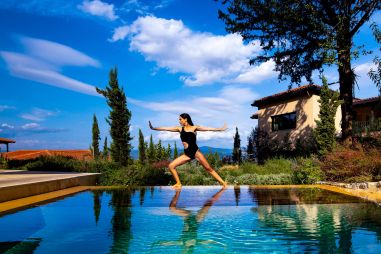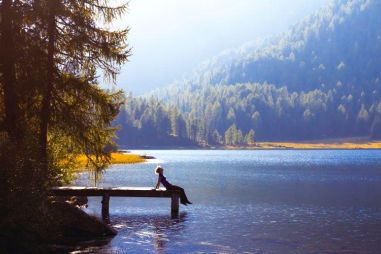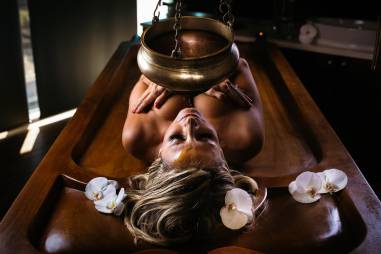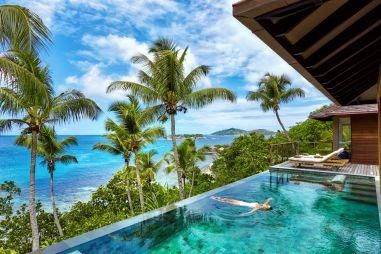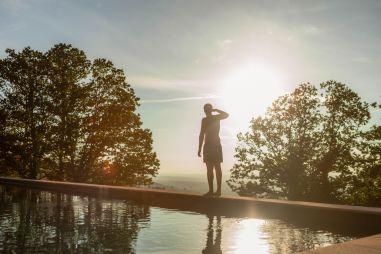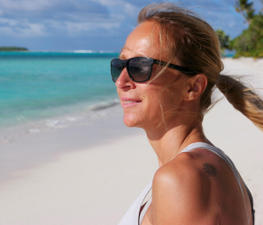Puurenkuur review: Claudia's trip to India and Nepal
With Ayurveda on my mind and curiosity in my heart, I board a flight to Mumbai, already bracing myself for the swirl of noise, color, and movement I’ve heard so much about. Over the next three weeks, I’m not just traveling - I’m stepping into a journey through health resorts and Ayurveda retreats across India and Nepal, places that have long drawn seekers of balance and healing. From Mumbai, I drift inland to Pune, then journey south to Kerala, where Ayurveda was born and still feels alive in every detail. Later, I trace my path northward, toward the spiritual pulse of Rishikesh and Haridwar, before finally crossing the border into Nepal.
The day before my arrival in Mumbai, I receive my driver’s details via WhatsApp and email. The transfer includes VIP service, a true luxury: from the moment I step off the plane, I’m met at the gate by a guide who steers me quickly through immigration, takes care of my luggage, and leads me straight to the car. My journey has begun!
My first stop is Atmantan, a luxury adult-only resort tucked away from Pune’s bustle, surrounded by mountains and overlooking Lake Mulshi. During monsoon season, from June to September, waterfalls cascade down the hillsides, and legend has it that the crystals in this region carry healing powers for anyone nearby. Right now, though, the rain is mostly pouring straight from the sky.
- Arrival in Atmantan
- Physio, Sports, Weight Loss, Wellness & Ayurveda
- Wellness Cuisine at Atmantan: true nourishment
- SOUTH OF INDIA
- South India’s Kerala, the birthplace of Ayurveda
- Somatheeram Ayurveda Village
- Soma Manaltheeram Ayurveda Beach Village
- Ayursoma Ayurveda Royal Retreat
- Nikki Nest
- NORTH OF INDIA
- Journey to the State of Uttarakhand
- My stay in Six Senses Vana, Dehradun
- Six Senses Vana: wellness, cuisine and location
- Arrival in Ananda in the Himalayas
- Ananda in the Himalayas
- Kapha-, Vata- and Pitta-menus
- Traditional Chinese Medicine in Ananda
- NEPAL
- Arrival Kathmandu
- Begnas Lake, Pokhara
- Begnas Lake Resort
- Begnas Lake Cuisine
- Reflections on my wellness journey in India and Nepal
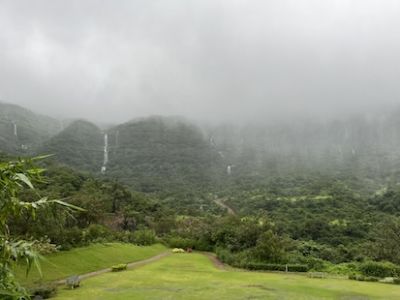
Arrival in Atmantan
By the time I reach Atmantan, night has already fallen. The drive takes nearly four hours—leaving Mumbai airport, passing through Pune, and winding further up into the mountains before finally arriving at the resort. You can also fly, but this time I decided to take the road. The next morning I wake to the sound of heavy rain. Monsoon season is in full swing. As I wander through the resort grounds, I notice how alive everything feels—the air is fresh, the hillsides lush, the greenery almost glowing. The mountains surrounding Atmantan and the quiet view over the lake create an immediate sense of calm. Atmantan was founded in 2016 by Nikhil, a devoted sports enthusiast. Since then, it has grown into a well-known international destination spa, attracting wellness travelers from all over the world. Its name reflects its philosophy: the divine connection of mind (mana), body (tann), and soul (atma).

Physio, Sports, Weight Loss, Wellness & Ayurveda
My stay at Atmantan starts with a consultation with the Ayurvedic doctor. Before leaving home, I had filled out a detailed health questionnaire, so everything is tailored to me from the start. That’s the hallmark here: highly personal service designed around each guest. While Ayurveda is central, Atmantan’s real edge lies in its focus on physiotherapy, sports, and movement.Specialist physiotherapists carry out a full body assessment. I go through a posture analysis and walk away with practical advice on how to strengthen my muscles and improve alignment. It’s a hands-on approach that sets Atmantan apart from many other Ayurveda retreats in India, where the emphasis is often more traditional. The fitness facilities alone are remarkable: a 3,500-square-meter high-tech gym with dedicated studios for aerobics, spinning, yoga, and pilates. Atmantan can easily hold its own against world-renowned destination spas like Kamalaya or Chiva-Som. The focus here is health in the broadest sense, with programs ranging from detox and weight loss to fitness training and mental wellbeing. And the luxury extends beyond the treatments: there is an indoor heated pool and an outdoor pool, a beautiful spa, and a wide variety of holistic classes and activities.
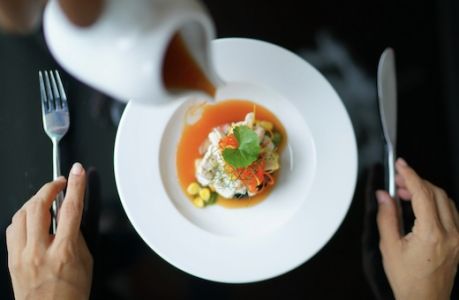
Wellness Cuisine at Atmantan: true nourishment
The food is simply delicious. I can choose between three menus: Cleanse, Wellness, or Ayurveda. Most days I go for the Wellness or Ayurveda menu, with little extras like apple cider vinegar shots or ashwagandha tonics. The Wellness menu is the main one, filled with light, low-calorie dishes, while anyone training more intensively can opt for a protein-rich version. The chef is incredibly flexible - whether I want an extra meal or a larger portion, it’s never a problem. Each dish is well balanced, with the right mix of fats, carbs, proteins, and fiber. Everything is clearly labeled too, showing if it’s suitable for diabetics, dairy-free, nut-free, vegan, or gluten-free. All meals are made with natural, unprocessed ingredients, and much of it comes straight from Atmantan’s own organic farm.
For more information and booking: Atmantan Wellness Resort
SOUTH OF INDIA
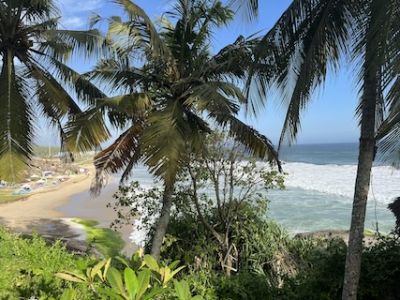
South India’s Kerala, the birthplace of Ayurveda
My next stop is Trivandrum, in Kerala—the southern tip of India and the birthplace of Ayurveda. The sun is out, the air is warm, and I’m surrounded by palm trees, endless beaches, winding backwaters, and the Arabian Sea. It’s no wonder this region is also a favorite holiday spot for many Indians. Over the coming days I’ll be exploring three well-known Ayurvedic resorts here: Somatheeram, Manaltheeram, and Ayursoma. They share the same owner, all are fully certified, and each sits along the same stretch of coastline. One is tucked closer to the water than the others, but the beach itself seems to go on forever. Meals are served buffet-style with classic Ayurvedic dishes, and you can choose anything from a short wellness break to a longer Rasayana or Panchakarma program. At first glance the resorts look alike, but spend a little time in each and the differences begin to show.
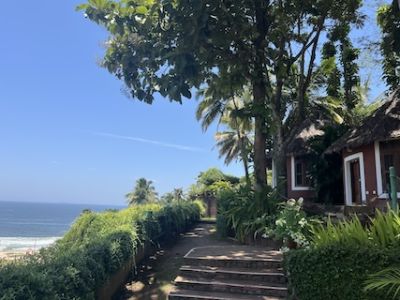
Somatheeram Ayurveda Village
Somatheeram has a calm, relaxing atmosphere. The rooms are scattered among the greenery, which gives a sense of privacy. The resort itself is spacious and open, set on a hillside, so you’ll find steps in places. The beach is the furthest of the three resorts, but gives beautiful views. Yoga sessions are held on the top floor of the restaurant and reception building, with a fine view over the sea. The special cottages also overlook the ocean, though they sit a little further from the Ayurveda centre. For anyone who values peace, space and nature, this is an easy place to feel at home.
For more information and booking: Somatheeram Ayurveda Village

Soma Manaltheeram Ayurveda Beach Village
Manaltheeram sits on a smaller piece of land and has a more intimate feel. There is less privacy, as everything is closer together, which makes the place easy to navigate. The sea is much nearer, and during the monsoon it can be rough – earplugs are worth bringing. Yoga sessions take place outdoors, on a platform right by the water, with the sound of the waves in the background. The cottages and rooms are tucked among flowers and plants, each with its own outlook and character. Distances are short, so you move quickly from one spot to another. A special feature here are the open treatment rooms with sea views. Manaltheeram is a good choice if you like being close to the sea and enjoy a livelier setting.
For more information and booking: Soma Manaltheeram Ayurveda Beach Village

Ayursoma Ayurveda Royal Retreat
Ayursoma Ayurveda Royal Retreat is the Somatheeram group’s newest five-star resort, set closer to the sea. The five buildings are finished with traditional Indian woodwork, with the main one home to the reception, restaurant and an Ayurveda centre with nineteen treatment rooms. Certain rooms come with a private treatment room for consultations and therappy, making the place easier when you are less mobile. Yoga takes place in two spots, one at the Ayurveda centre and one in the clock tower, while the food, treatments and medical care follow the same approach as the other resorts, offering support for conditions such as rheumatism and joint pain.
For more information and booking: Ayursoma Ayurveda Royal Retreat

Nikki Nest
Ten minutes down the road you’ll find Nikki’s Nest, a small family-run resort managed entirely by women. You notice this in the details, from the handmade bags to the well-kept rooms. Treatments follow a set structure: the first day begins with a consultation and one hour of therapy, then builds up to two or three hours a day, depending on the doctor’s advice. Guests arriving before three o’clock can usually start the same day. Yoga is part of the daily rhythm, with a one-hour session and half an hour of meditation each morning from Monday to Saturday, plus another session in the afternoon. On Sundays there are lectures on themes such as nutrition and herbs. The grounds are well maintained, with a pool and sun deck, and all water is recycled for the gardens. Wifi is available only in the common areas. Meals are Ayurvedic, served buffet-style at long community tables. Nikki’s Nest combines Ayurveda, yoga and a sense of community, strengthened by its small scale and shared dining.
For more information and booking: Nikki's Nest
NORTH OF INDIA
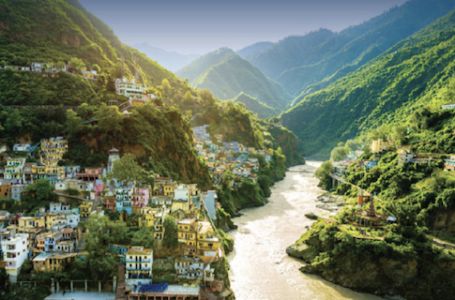
Journey to the State of Uttarakhand
I leave Kerala behind today and head north: first to Delhi, then on to Dehradun. At the foot of the Himalayas, the atmosphere shifts instantly. Northern India combines striking landscapes with deep tradition—forests and rivers meet villages shaped by centuries of pilgrimage. The air is cooler, the light sharper, and the outline of the mountains frames the horizon. From Dehradun, the road leads to Rishikesh and Haridwar, two sacred cities on the Ganges where yoga schools, ashrams and temples draw seekers and pilgrims from around the world.
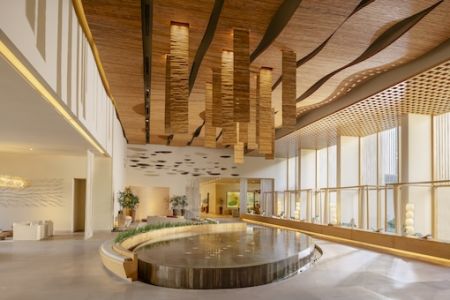
My stay in Six Senses Vana, Dehradun
Tonight I’m staying at Six Senses Vana, which they describe as a luxury five-star 'ashram'. The design is sleek and modern, with high ceilings, plenty of wood and an interior that feels ready for the pages of an architecture magazine. In my room there’s a kurta - a simple, comfortable white outfit that most guests wear throughout the day. What stands out is the breadth of holistic therapies and the expertise of the doctors. Ayurveda is blended with Traditional Chinese Medicine and other practices. I undergo a detailed body analysis with electrodes, an Ayurvedic pulse reading and receive advice tailored to my own goals. The resort has a separate Ayurveda centre, a TCM doctor offering acupuncture and Tibetan treatments, and a long list of other therapies and massages. My session with the TCM doctor left a strong impression.
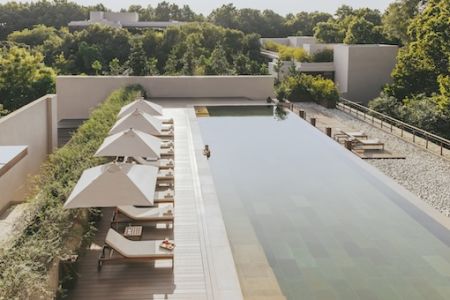
Six Senses Vana: wellness, cuisine and location
Six Senses delivers a full wellness experience in a luxurious setting. Beyond Ayurveda programmes, there are options for detox, weight management, relaxation, stress relief and mental balance. I join a sound healing session that leaves a lasting mark. The food is light, healthy and beautifully prepared, with both Indian and European flavours. Breakfast combines buffet and à la carte, lunch follows the same pattern, and dinner comes as several small courses. Portions are modest, but you can always ask for more. The doctor may recommend certain dishes, teas or juices, though you are free to decide what and how much to eat. Coffee and fresh juices are also available. The location offers variety. Dehradun, with its parks, caves and temples, is close by, while Rishikesh is about 70 minutes away, a pilgrimage town on the Ganges where the evening Ganga Aarti ceremony draws pilgrims and travellers alike.
For more information and booking: Six Senses Vana
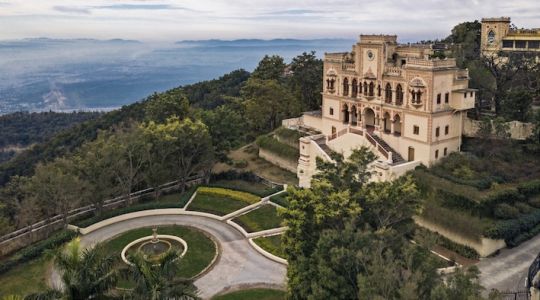
Arrival in Ananda in the Himalayas
As afternoon fades, the journey from Six Senses Vana to Ananda in the Himalayas winds for an hour through forested hills. By the time the sun dips low, the gates open to reveal the palace, rising with the quiet authority of a grand dame watching over her grounds. Ananda is widely recognized as one of the world’s leading destination spas, celebrated as an exclusive retreat for holistic wellbeing. The estate, set across 100 hectares in the Himalayan foothills, once belonged to the Maharaja of Tehri-Garhwal. At its heart stands the Viceregal Palace, built in 1910 and beautifully restored. Traditional attire, stately interiors and a stillness that seems almost tangible give the place an atmosphere of timeless elegance.

Ananda in the Himalayas
Since opening in 2000, Ananda has earned its place as India’s pioneering destination spa, repeatedly celebrated by international travel and wellness magazines. Its philosophy is built on balance: Ayurveda, yoga and Vedanta are seamlessly combined with modern wellness and Western therapies. Ayurveda anchors the approach, enriched with elements of Traditional Chinese Medicine, physiotherapy and practices that restore emotional harmony. Posture and movement are refined through physiotherapy, yoga programs extend from restorative sequences to yogic detox, and therapies for emotional renewal complete the circle—together forming a holistic system that feels both ancient and contemporary.

Kapha-, Vata- and Pitta-menus
After checking in, I head straight to the spa, where a Stress Release massage is the perfect way to begin my stay. The space is vast—over 2,000 square metres with 24 treatment rooms, a modern fitness centre, a heated outdoor pool and hydrotherapy facilities. That evening, before meeting the Ayurvedic doctor, I choose dinner from the Kapha, Vata and Pitta menus. Unsure which to pick, I take the waiter’s advice and try smaller portions from two. A fragrant soup and two beautifully balanced dishes leave me feeling light and content as I end the day.
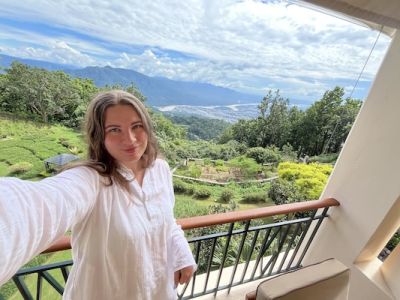
Traditional Chinese Medicine in Ananda
Early morning light pours into the room and wakes me gently. From my bed I look out over the valley, already bathed in sun. After breakfast, my first appointment is with the Ayurvedic doctor. He explains how the diagnostic process works and maps out my dosha: physically Kapha, emotionally a blend of Vata and Pitta, with Vata out of balance. From this comes his dietary guidance, and together with the chef I create a menu designed to restore harmony. Most of the meals follow Ayurvedic principles, yet there is still space for variety - at breakfast, for example, I can order eggs and coffee from the à la carte menu. Later in the day I meet the TCM doctor, who works with acupuncture, cupping and moxibustion; afterwards she remarks that my Chi feels stronger. The days that follow unfold in a rhythm of indulgent treatments: a four-handed abhyanga massage performed in perfect synchronicity, Ananda’s signature fusion of warm oils and herbal poultices, and finally the deep grounding of a Tibetan Kyu Ne massage.
For more information and booking: Ananda in the Himalayas
NEPAL
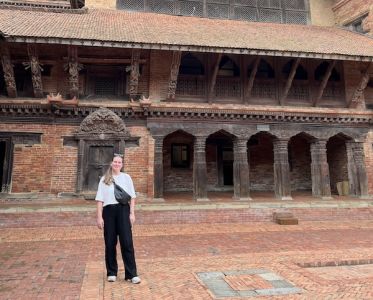
Arrival Kathmandu
With India behind me, the journey takes me on to Nepal. I touch down in Kathmandu for an overnight stay before continuing to Pokhara. When booking an Ayurveda retreat at Begnas Lake, this night in Kathmandu is included - a welcome pause after the long flight from Europe. The next morning I visit the main temple and Kathmandu Durbar Square, the historic heart of the old city, and by afternoon I’m on a short hop to Pokhara: twenty minutes by plane instead of five hours by car.

Begnas Lake, Pokhara
Begnas Lake is the second largest lake in the Pokhara Valley, around fifteen kilometres from the city. Unlike the busy Phewa Lake, Begnas is peaceful and quiet. Its waters are clean and still used by local people for fishing and irrigation. Around the lake lie small villages, rice fields and forests, while from the surrounding hills there are views of the snow-covered peaks of Annapurna and Manaslu. The lake is never the same twice: in the early morning a light mist hangs over the water as fishermen set out in wooden boats; by afternoon the surface sparkles in the sun, reflecting the mountains; and by evening the air falls still, with only the sound of crickets and birds.
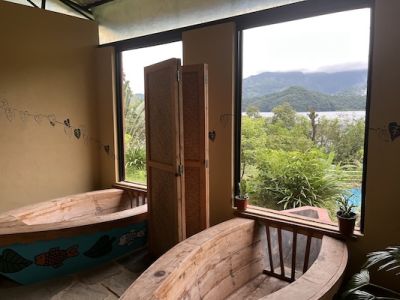
Begnas Lake Resort
Begnas Lake Ayurveda Resort is set on the shore of the lake, accessible only by road or by boat. Its secluded location is part of the experience: life slows down, silence deepens, and the lake and mountains shape the rhythm of each day. The resort is dedicated to Panchakarma and Ayurvedic programmes. My stay begins with a consultation with a doctor from South India, who designs both treatments and meals around my needs. Dishes are individually prepared and served at your table, or in the room if preferred. Before each session I meet briefly with the doctor, who monitors my progress. Days unfold with two to four hours of therapy, complemented by yoga or sound healing in the morning and evening. The atmosphere is simple yet comfortable. The spa lies at the water’s edge, the rooms are set just above, and at the top of the hill are the restaurant and reception. I swim in the pool or in the lake, watching buffaloes graze along the shore and children playing in the shallows, while the Himalayas rise in the distance - a magical moment.
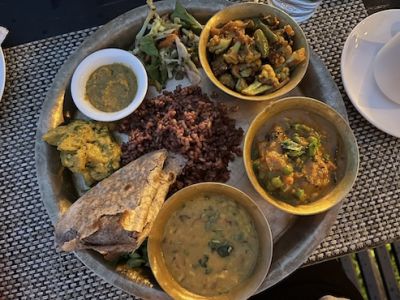
Begnas Lake Cuisine
At Begnas Lake Ayurveda Resort the meals are a central part of the experience, with Ayurvedic cuisine given a local Himalayan character. Dishes are prepared with seasonal vegetables, lentils, buckwheat, millet and rice, much of it grown in the resort’s own organic gardens. The Jimire restaurant serves personalised meals tailored to your dosha type, alongside herbal teas and fresh local produce. Reviews often highlight the food as a reason to return. Visitors describe the dishes as exquisite' and 'lovingly presented', while others mention that the meals designed for their Ayurvedic type were 'wonderful' and made them feel supported in their health goals. The kitchen also caters easily for vegetarian, vegan, gluten-free and other dietary needs, making it accessible to all. In many ways, the cuisine here goes beyond nourishment. Each dish feels thoughtful and restorative, aligned with the holistic approach of the resort. It is wellness on a plate, complementing the therapies and the natural setting, and leaving many guests with the impression that the food alone is worth the journey.
For more information and booking: Begnas Lake Resort

Reflections on my wellness journey in India and Nepal
Returning from this journey, it is hard to capture everything in a single story. Every stop - each region and country - had its own rhythm and beauty. I learned much about Ayurveda, but just as much about health, rest and balance. Atmantan brought structure and movement. Kerala slowed me down and let me give myself fully to the ayurveda treatments. In the north, the stillness and spiritual presence of Vana and Ananda reached me, together with the centuries-old healing and holistic therapies. Nepal closed the circle. Standing among the great mountains made me feel small and deeply humble. I went in search of Ayurveda and a better understanding of wellbeing, but what stays with me most is a clearer sense of balance and the habit of listening to what my own body is quietly telling me.
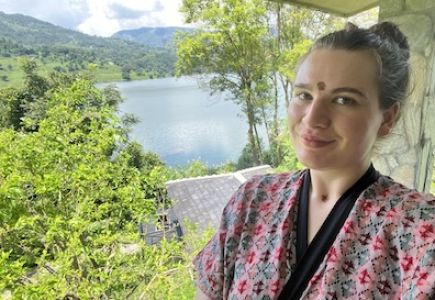
About Claudia
This blog is written by Claudia, who has been with PureandCure since 2018 and now works as Marketing & Product Manager. With an international background and strong attention to detail, she is a valuable part of our team. Claudia regularly visits Puurenkuur destinations—health resorts, spas and retreats—and shares her experiences in these blogs.

 EN
EN NL
NL BE
BE